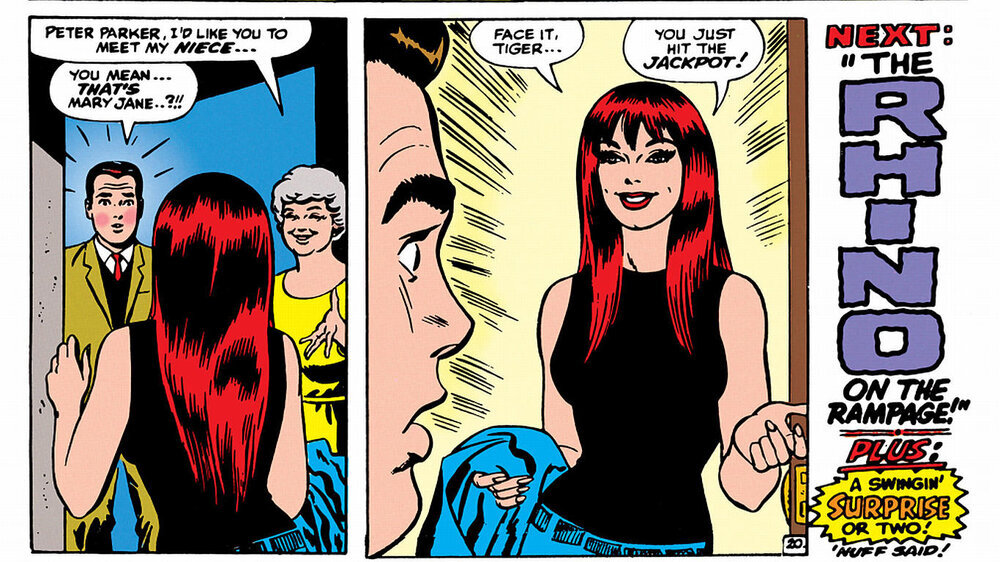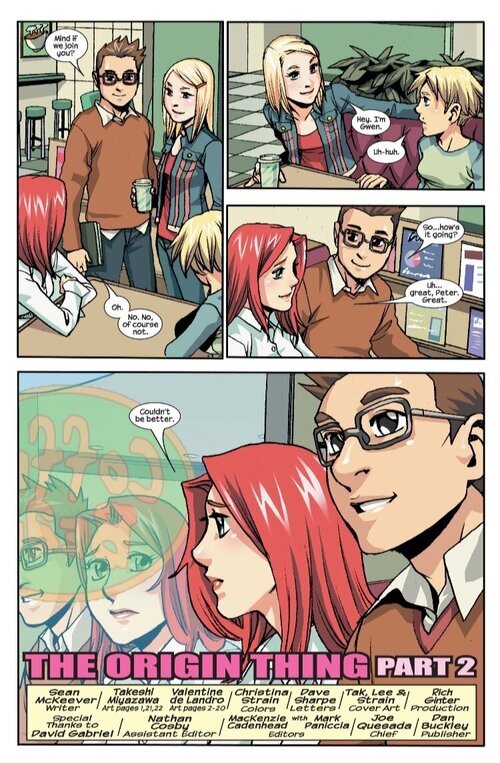Mary-Jane Watson and Mythology
Comic books have become a type of American mythology. We don’t have stories of Prometheus coming off Olympus giving the gift of fire, but we do have these stories we invented to show what we’d do if we had the chance to be greater. Most myths explain why things are. Comics explain how things could be.
The finer details bend depending on who’s telling the story and when it’s being told, but the broad strokes always remain the same because that’s how myths work. Each storyteller adds their own flare but adheres to the same general outline that everyone knows. Not everybody knows the words to the number one Billboard track right now (What’s Next, by Drake in case you were wondering), but everyone knows the words to Old McDonald. Some things transcend and bury themselves in you.
Everyone knows that Superman crashed in the fields of Kansas as a baby. Everyone knows Bruce Wayne’s parents were gunned down in an alley. Everyone knows that the world hates and fears mutants. In the mid 2000’s we knew something else—we knew that Spider-Man loves Mary Jane.
yes, this book is as fun as it looks
Originally conceived as fun party girl, Mary Jane famously was best known as Peter Parker’s on again, off again paramour until they married in the early 90’s. She was an aspiring actress and free-spirited woman who embodied the go-with-the-flow attitude that was popular around her inception. She’s always one point in the multi-angled shape that occupies Peter’s love life, or rather, he was in hers. I don’t know why I’m telling you this, because you already know it.
That’s what made Spider-Man Loves Mary Jane such a fun series. We hadn’t really seen young MJ since the 60’s, when she was a go-go dancer at the Gloom Room. Spider-man Loves Mary Jane turns the clock back to MJ’s high school years but in a modern setting. Anyone who reads this blog knows my affinity for early y2k fashion and culture and this book is rife with it. It’s about 10th graders in 2004 and hey guess what I was a 10th grader in 2004, so yeah, this story means a lot to me.
The only annoying thing about the series is its format, but thankfully that’s been corrected in the collected editions. The book was meant to appeal to a younger female audience that was becoming an increasingly large part of the manga market. Mary Jane was a four issue miniseries that came under the Marvel Age banner, an all-age imprint that featured classic heroes and villains in classic situations, without the burden of continuity or complexity. By the time the book sales proved out, Marvel Age folded as an imprint, but a sequel series called Mary Jane: Homecoming was released from the same creative team. After that, it became a twenty issue ongoing series that lasted through 2007.
I don’t like hyperbole but when I tell you this is one of the most important panels in comics, I’m not lying.
So, Mary Jane was the little series that could, and if you’re the kind of person who liked that show The OC, then it was very good. Told from outside the greater Marvel continuity, everything that happens is from Mary Jane’s perspective… and much like The OC (or Dawson’s Creek, Melrose Place, One Tree Hill, pick your poison), it’s a high school soap opera. Mary Jane is trying to be a normal teenager in a world that’s becoming less normal everyday. She’s trying to find out what she’s passionate about, be a good friend, student, and daughter all while navigating the minefield that is teenage love.
There are moments that’ll kick your heart right in the teeth. Through all the ups and downs of the two mini-series that precede the ongoing, Mary Jane can’t shake the feeling that she’s supposed to be with Spider-man, probably because at the time the Sami Raimi directed Spider-man movies told us that Spider-man and MJ were supposed to be together. There mythology goes again, mythologizing all over us.
Her hands are never cold. She’s got Kirsten Dunst’s eyes
Where the tension kicks in, is the triangle that erupts between MJ, Spider-man and Peter Parker. Keeping his secret identity actually a secret, Pete wanted MJ to like him, not his costumed alter-ego. When he finally shoots his shot he misses like Shaq at the free-throw line.
Firestar, a character first introduced in Spider-man and his Amazing Friends, an 80’s cartoon shows up as another romantic interest, which is just another case of the mythology folding in on itself. Every Spider-man story is true and none of them are all at the same time.
One of the more impressive accomplishments was the “Dark Mary Jane” storyline, a play on the Dark Phoenix story from X-Men decades earlier, one of the most iconic storylines of all time. MJ has her heart broken by an upperclassman she’s dating and becomes the wettest blanket in the history of damp bedding. She feels like she can’t sink any lower until she sees Pete in the aftermath of Uncle Ben’s death and she finally snaps out of it, coming back to her senses and realizes that if the death of Peter’s uncle isn’t the end of his life, then her broken heart isn’t the end of hers. By the time Mary Jane realizes the mistake she made turning down Peter for Spider-man, Gwen Stacy shows up in the book to be the newest wrinkle. Because the story of Mary Jane can’t be fully told without Gwen Stacy. Why?
Because Gwen Stacy was the love of Peter’s life. They were supposed to spend the rest of their lives together, but the Green Goblin threw her off the Queen’s Bridge and Peter failed to save her. She died, and it haunts Peter… but if you ask a hundred people who Spider-man’s love interest is. They’d say, well, Spider-Man loves Mary-Jane.
Wait, did I say the Green Goblin threw Gwen off a bridge and Spidey failed to save her? Why does that sound familiar? Oh yeah.
Anyways, back to the book. Not every story revolves around Peter though, she isn’t defined by her relationship to any one dude in her life. If anything, the story is about maintaining her relationship with her best friend, Liz Allen, a confident, aggressive young woman who’s Mary Jane’s rock. The men come and go, but the most important thing at the end of the day is her friendship with Liz as she tries to figure out who she really is as a person.
What’s most great about the story is how it takes so many disparate aspects of this character’s 40 year life-span across all mediums and blends them into what feels like an actual, real teenager. All the high-concept drama from the regular book (clones, kidnapping, miscarriage, marriage, divorce) was done away with but it never doesn’t feel like a Mary Jane book. This addition by subtraction is absolute proof that the Mary Jane concept isn’t just integral to the Spider-man mythos but that the character was so strong at her inception she transcends generation, setting, relationships, and even art styles. Mary Jane as a character has the capacity to exist at any time, with or without Spider-man. If you tell a story about him, it’s almost impossible to not have her in the back of your mind. You’re waiting for her like a punchline.
She’s the chorus to a song you can’t remember but somehow know all the words to. She was a four-color knockout who lived on paper and celluloid since the 60’s but she’s been tattooed on the back of our eyelids. She doesn’t fight Green Goblin, she doesn’t fly with Superman, but she has to feel like a real person to explain this surreal world we see. She’s an integral part of the mythology of comics, the stories we invent for ourselves when we’re trying to explain what we’d do if we had the chance to be greater.
And MJ is always going to be part of that story because that’s how mythology works, and Spider-man’s mythology simply can’t work without her.
this post was originally published on March 16, 2021







